How Manufacturers Can Save Millions Through Incentives Programs
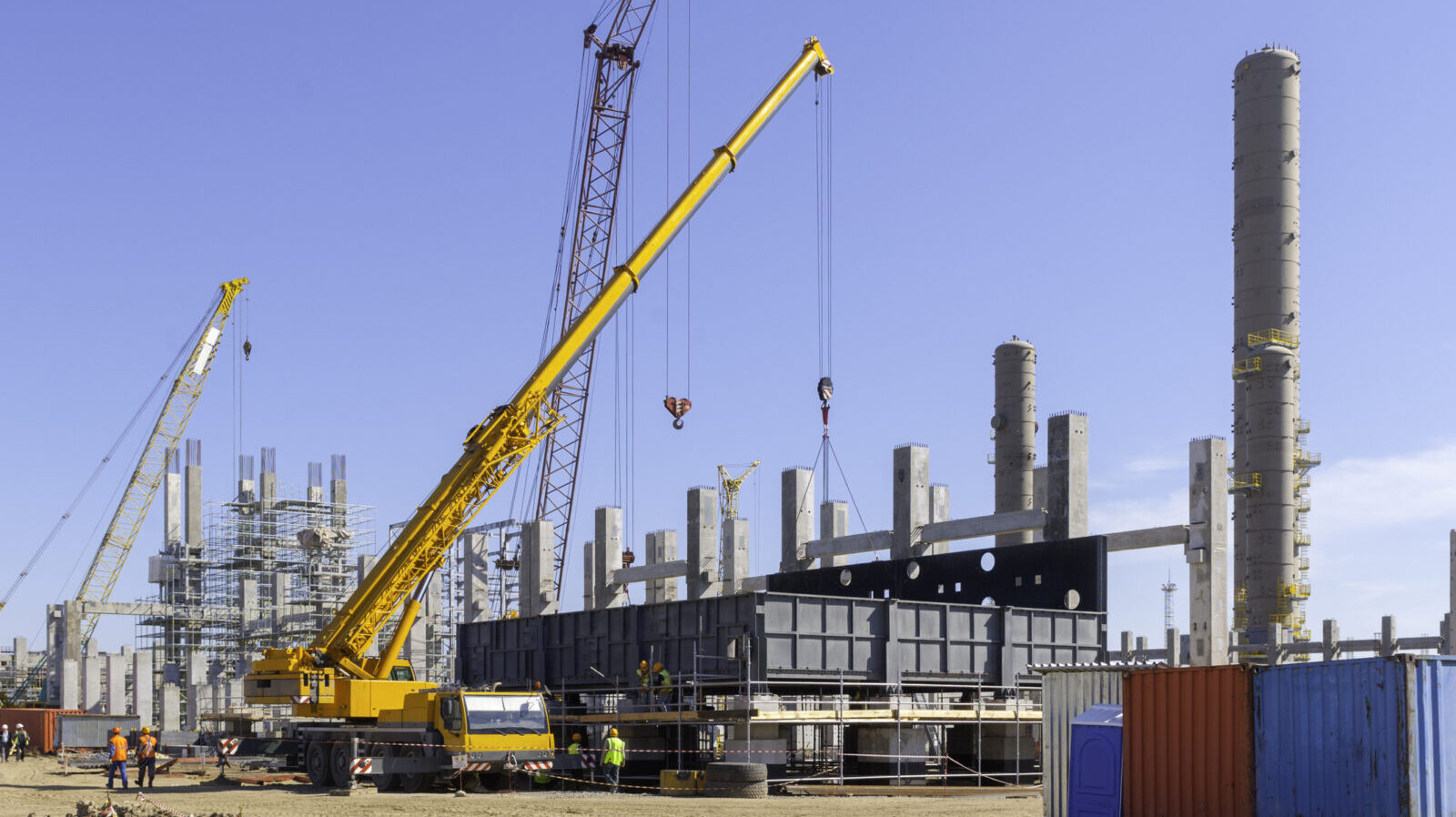
“$80 billion is given away every year in state and local incentives,” according to Atlas Insight Managing Partner Brian Corde. “Plus, the Biden administration has added $455 billion just in federal grants.”
In this investment landscape, manufacturers need all the help they can get finding, applying for and complying with these incentive programs. Atlas Insight, the NAM’s partner for its Incentives Locator, walks companies through this entire complicated process.
Last week, we talked to Corde and Kathy Mussio, Atlas’s other managing partner, about how companies select their new sites. This week, we’ve asked them what manufacturers need to know about incentives.
How do incentives work? Incentives come in two forms, Corde and Mussio explained. First is the type you automatically qualify for if you meet the requirements, known as statutory or as-of-right incentives.
- The second is the type that Atlas lends its expertise to—discretionary incentives. These programs offer funds and other pools of money that require business cases, negotiation, applications, and later, proof that a company has met its stated obligations (also known as compliance).
- These programs can take many forms. As Mussio put it, “Some states have programs that offer cash to help close the financial gap between two competing locations or increase a project’s ROI—helping to make a location more competitive in the financial analysis.”
- There are many, many incentives out there, the Atlas partners told us, and the most important steps are understanding which ones a company may be eligible for and helping clients quantify the potential savings.
What if you’re staying put? These incentives aren’t just for new facilities, Corde and Mussio emphasized. “A majority of incentives are given to companies staying in place,” Corde added.
- Companies can take a lot of actions to qualify for incentives—expand their workforces, buy new equipment, train workers in new technologies or add square footage for new production lines.
- “It’s our job to help NAM members identify their projects that could use incentives. Then we benchmark the incentives, then negotiate on the companies’ behalf, then lock the incentives down with the state or city,” Corde said.
What’s benchmarking? Atlas compares incentive offers from states and localities with the incentives awards that similar companies have received in the past, another way to help ensure that their clients get the best possible deals. There’s always room for negotiation, the partners say.
- Atlas keeps two databases: the first, a listing of all the incentives that exist on the federal, state and local levels, along with all the necessary forms, key contacts and any other requirements. The second database is a list of what other companies have received for similar types of projects.
- This allows Atlas to identify the typical dollar range that an incentive should provide—so a company knows whether it has been offered a good deal, and whether it should negotiate, or even go elsewhere.
How do you get the money? After companies successfully secure an incentive award, they must follow compliance schedules to ensure they keep receiving the funds as project milestones are met, while also retaining documentation in case of audit.
- The government offering the incentive typically requires filings to verify how many employees were hired, the wages they earned, even the employers’ contributions to health insurance premiums.
A lot to lose: “We are being conservative when we say that 50% of incentives awarded never pay out,” Corde said, all because companies fail to fulfill compliance requirements.
How can Atlas help? Atlas creates a “holistic incentive management for its clients, for the entire life of the incentive,” so that companies actually receive their money, the partners explained. It even helps with old incentives that remain incompletely documented.
- “When we retained Atlas, it enabled us to bring several one-off incentive agreements around the U.S. into a centralized process,” said a Schneider Electric spokesperson. “That made it so much easier for us to document our part of the expansion agreements and collect the incentives we were owed. Plus, their performance-based fee for this process has been best in class.”
How to get started: The NAM Incentives Locator is a service for NAM members, which provides a complimentary initial assessment call and preferred rates on contracted services, including an exclusive success-based fee schedule.
- Atlas is often “only paid for successful outcomes, either a confirmation letter or when the company receives the money over time. We will help you be successful and then benefit once you are,” said Corde.
The bottom line: “You need to have a strategy to go after these incentives, because your competitors are.”
Lucid Revs Up the Domestic Graphite Supply Chain
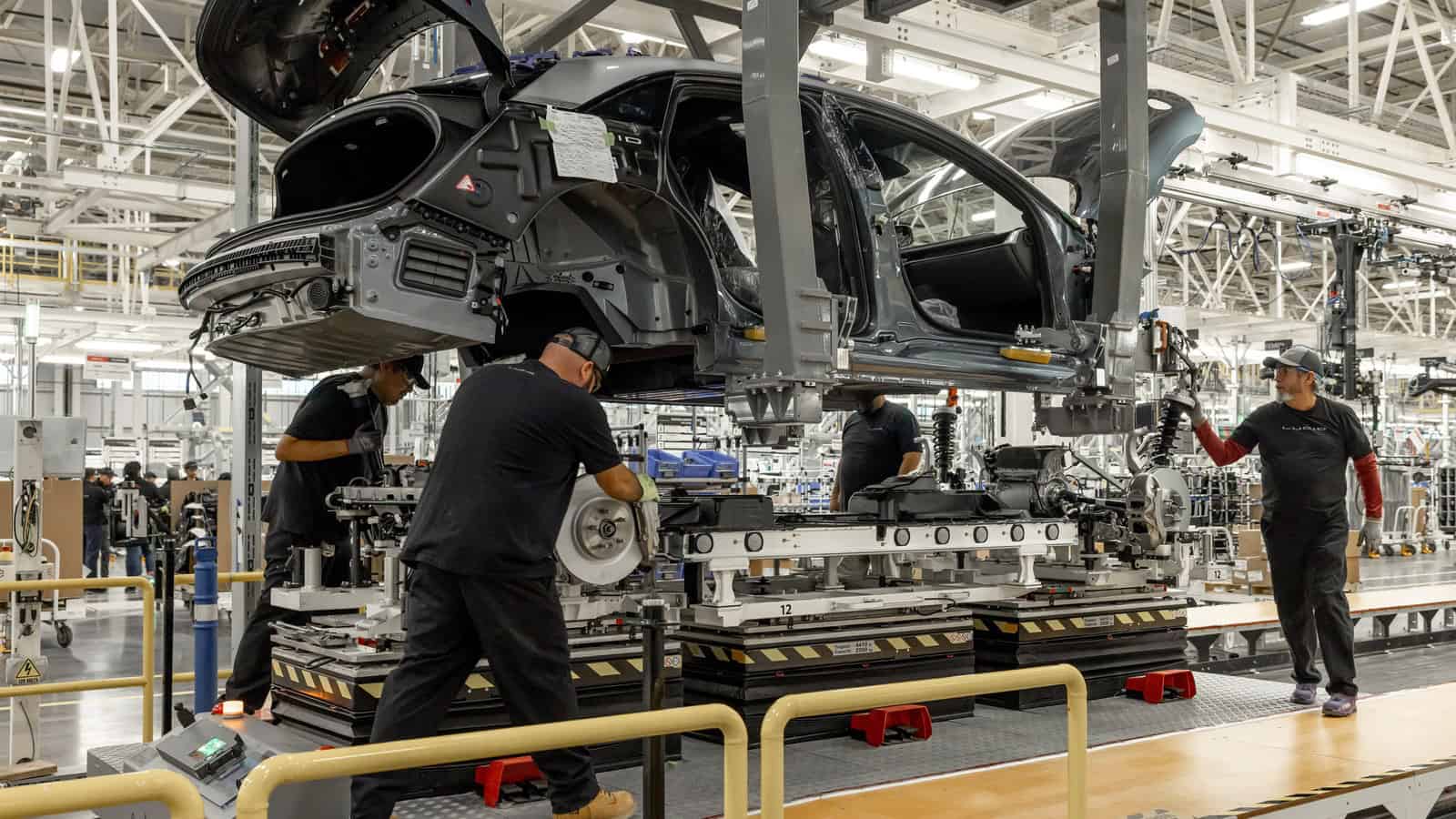
Lucid has already made one of the most energy-efficient cars on the market. Now the company is on a mission to strengthen supply chains for the critical materials powering its award-winning vehicles.
Supply chain warrior: The California-based electric vehicle manufacturer—whose 2025 Air Pure sedan is the first EV to achieve a milestone 5 miles of range per kilowatt of energy—recently reached an agreement with Alaskan mining exploration company Graphite One to purchase synthetic graphite for its vehicles’ battery packs.
- The deal, which goes into effect in 2028, is a crucial first step toward cementing a domestic supply chain of graphite, a mineral that makes up about half of every EV’s battery composition. EV batteries require both synthetic and natural graphite.
- “Today 100% of the graphite for batteries assembled in the U.S. comes from overseas,” said Lucid Motors Supply Chain Group Manager of Battery Raw Materials Michael Parton. “Building a robust domestic supply chain ensures the United States and Lucid will maintain technology leadership in this global race.”
Pandemic lesson: The global pandemic revealed the downside of depending on other nations for critical materials, and the importance of cultivating domestic sources instead.
- In 2020, “every company experienced major challenges when it came to shutdowns and global trade,” Parton said. “Having a domestic supply reduces production risk, accelerates response time and agility and lowers the need to carry higher levels of inventory.”
A midstream gap: When it comes to EV batteries and their supply chains, “much of the discussion is on localizing the bookends of the supply chain, the downstream battery production and the upstream mineral extraction,” Parton told us.
- Less discussed is the “midstream environment,” which comprises the precursor cathode active materials (P-CAM) and cathode active materials (CAM) stages. Materials used during these phases in the battery production process include critical minerals such as lithium, nickel and cobalt.
- The P-CAM market has been a difficult one to navigate, Parton added. For years, the P-CAM stage has been outsourced to countries with more cost-effective production. The problem: These countries also have less stringent environmental regulations than the U.S.
- “There’s limited investment announced [in the U.S.] in the refining and chemical conversion process at these stages, but it’s where the real need is,” Parton continued. “To promote localized sources of supply for mined and recycled minerals, there needs to be a domestic option for both P-CAM and CAM.”
A bipartisan issue: Lucid’s advocacy for a strong domestic supply chain has won bipartisan support in Congress.
- “There’s something in it for everyone when it comes to efficiency,” said Lucid Motors Senior Manager of International and Trade Policy Emily Patt, citing the environmental and self-sufficiency benefits of a resilient domestic supply chain.
What’s next: Lucid is expanding its vehicle lineup beyond the Air and the vehicle’s four trim levels.
- By the end of 2024, the company is scheduled to start production of the seven-passenger Lucid Gravity. The company has also teased an upcoming midsize platform, which is expected to start production in late 2026.
The grand vision: “The pursuit of efficiency drives Lucid as a company,” Patt said. “We’re not just making zero-emission cars; we’re committed to making the best use of the world’s resources to maximize the benefits for electrification and the planet.”
Preserve Tax Reform’s Pro-Growth International Tax System

The international tax system put in place by 2017 tax reform bolsters American competitiveness and supports manufacturing in the U.S.—and that’s why its provisions must be preserved, according to a new policy explainer, part of the NAM’s Manufacturing Wins campaign.
The background: Before passage of the Tax Cuts and Jobs Act, the U.S. tax code made it more costly and less efficient to invest in the U.S. Corporate profits were taxed at the 35% corporate income tax rate when repatriated to the U.S., forcing businesses to keep revenues abroad.
- Tax reform instituted a new, pro-growth international tax regime that incentivizes companies to locate their operations, intellectual property and profits here in the U.S.
The specifics: Tax reform’s international tax provisions include the following:
- A 21% corporate tax rate: Tax reform reduced the corporate rate from 35% to 21%, making “the U.S. a more attractive home for manufacturing investment.”
- The Foreign-Derived Intangible Income deduction: This deduction “reduces taxes for companies that locate job-creating, export-producing intellectual property in the U.S.”
- The Global Intangible Low-Taxed Income regime: The GILTI regime imposes a U.S. minimum tax on income earned abroad in low-tax jurisdictions.
- The Base Erosion and Anti-Abuse Tax: The BEAT applies to certain payments that shift companies’ profits abroad.
Why it’s important: Globally engaged manufacturers face the possibility of significant tax increases at the end of 2025 as key international tax provisions are scheduled to change.
- The FDII deduction will decrease, while the effective GILTI and BEAT tax rates will both increase—upsetting the balance inherent in the TCJA international tax structure and thus making it more costly and difficult for globally engaged companies to operate here in the U.S.
What’s next: In addition to maintaining or reducing the 21% corporate tax rate, the NAM is calling on Congress to prevent the FDII decrease and the GILTI and BEAT tax increases on manufacturers whose success bolsters America’s competitiveness on the world stage.
The last word: “Congress must sustain tax reform’s international tax system, including the lower corporate tax rate, in order to enhance America’s competitiveness and support manufacturers’ efforts to create jobs and grow investment here in the United States,” said NAM Vice President of Domestic Policy Charles Crain.
How Johnson & Johnson Supports the Military Community
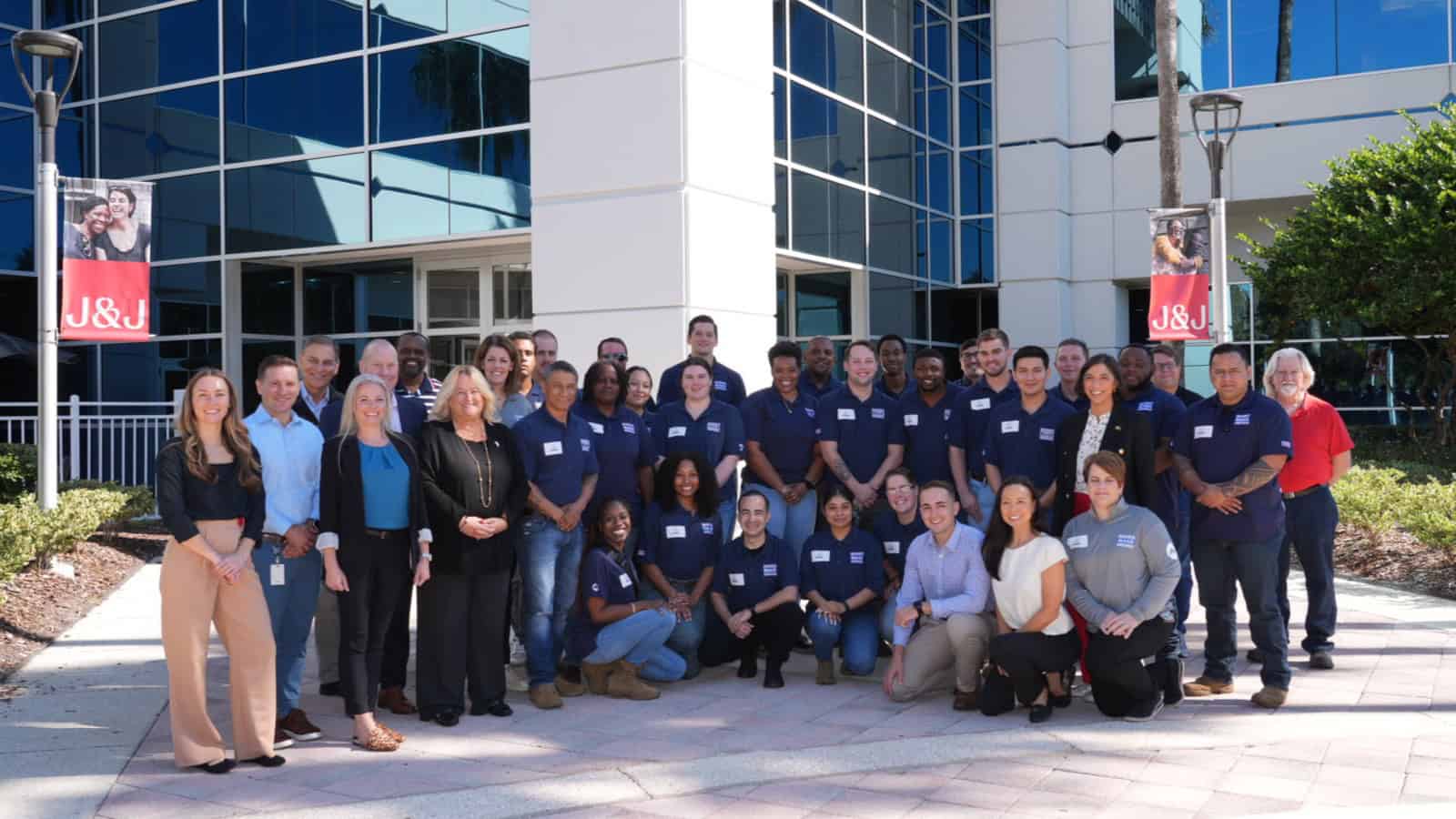
For more than a century, Johnson & Johnson has been a steadfast supporter of military service members. Today, one of the ways Johnson & Johnson fulfills this mission is by partnering with the Manufacturing Institute’s Heroes MAKE America initiative, which connects members of the military community with rewarding careers in manufacturing.
Both Johnson & Johnson and HMA firmly believe that military experience is invaluable for manufacturing careers. Veterans often have advanced problem-solving abilities, leadership skills and a strong work ethic—qualities that are essential in the fast-paced, dynamic environment of manufacturing.
The partnership: Since 2021, Johnson & Johnson has been the official health care sponsor of HMA. With their support, the initiative has continued to expand in-person and virtual training programs and helped more service members transition into rewarding manufacturing careers.
- Johnson & Johnson is a frequent host of facility tours for HMA students, as well as an active participant in Heroes Connect. These events provide military members with valuable insights into the manufacturing sector and allow them to connect with potential employers.
- The company also hires HMA graduates itself, employing three so far at its facilities.
Bringing careers into focus: On Nov. 15, Johnson & Johnson hosted 22 HMA participants from Fort Stewart in Georgia at its Vision Care site in Jacksonville, Florida.
- Johnson & Johnson Executive Vice President, Chief Technical Operations & Risk Officer and NAM Board Chair Kathy Wengel, MI President and Executive Director Carolyn Lee and NAM President and CEO Jay Timmons also joined the tour. (The MI is the workforce development and education affiliate of the NAM.)
- Wengel, Lee and Timmons participated in group discussions with HMA participants and held a fireside chat where they discussed their careers in manufacturing and Johnson & Johnson’s commitment to military hiring. They also gave advice to the HMA participants about working in the industry.
- “Veterans embody resilience, adaptability and dedication—qualities that are at the heart of manufacturing excellence,” said Wengel. “At Johnson & Johnson, we’re honored to work alongside Heroes MAKE America to support veterans in their transition to civilian careers, providing them with opportunities to build rewarding futures in manufacturing.”
From the MI: “Johnson & Johnson’s partnership has been crucial to our efforts to connect the military community with meaningful career opportunities in manufacturing,” said Lee. “They are an example of what it means to invest in veterans and support their transition into civilian careers.”
Get involved: To learn more about HMA and its incredible pool of talent, attend a virtual information session or email [email protected].
NAM Hosts 2024 Manufacturing Legal Summit
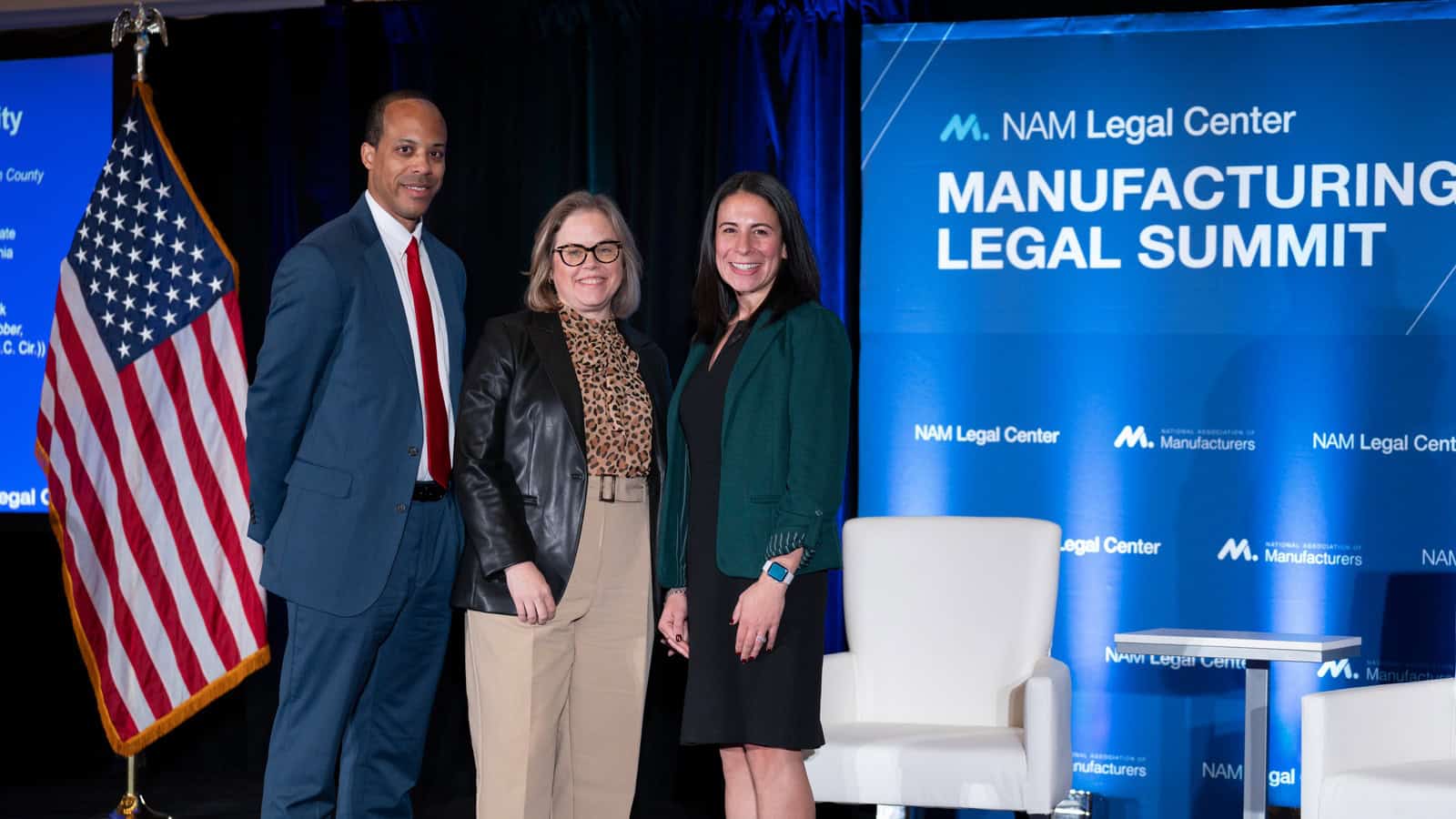
Manufacturers operate in a world of complex legal and regulatory challenges. In the wake of a national election, with a new administration and Congress on the horizon, those challenges are amplified, as in-house counsel must navigate a rapidly evolving compliance landscape.
The NAM’s third-annual Manufacturing Legal Summit, held Nov. 12–13 at the Willard InterContinental in Washington, D.C., helped in-house counsel at manufacturing companies map the road ahead. The event brought together nearly 150 such leaders from across the United States to share information and best practices.
The goal: “This is the only legal conference geared specifically for manufacturing lawyers,” said NAM Deputy General Counsel for Litigation Erica Klenicki. “What we hear consistently is that the opportunity to connect with others in the industry who are dealing with the same challenges is invaluable. Especially on the brink of a new administration and regulatory environment, we were able to provide connection and content that attendees found particularly helpful.”
The program: The Legal Summit covered a range of topics, including the following:
- Antitrust: A team of experts from Freshfields, including former FTC Commissioner Christine Wilson, joined with Saint-Gobain North America Senior Vice President, General Counsel & Secretary La-Toya Hackney to offer a candid deep dive into enforcement trends from the Biden FTC and what to expect from the new administration.
- Supply chain and ESG: Experts from Foley & Lardner joined Pelican Products Corporate Import/Export Compliance Manager Susan Cass to discuss the growing requirements surrounding supply chain transparency and integrity and best compliance practices for multinational companies.
- PFAS: Industry leaders from Greenberg Traurig provided a comprehensive overview of per- and polyfluoroalkyl substances, including the changing definition of PFAS, the regulatory landscape and how environmental marketing impacts risk, corporate strategy and consumer trust.
- Junk science: This product liability session offered strategies for combating junk scientific theories used to wage high-stakes litigation. It was led by experts from Shook, Hardy & Bacon, as well as Kimberly-Clark Corporation Associate General Counsel Kelly Vickers and Johnson & Johnson Assistant General Counsel Aviva Wein.
- NLRB: Experts from Fisher Phillips recapped the Biden Board’s sweeping changes to labor law and offered predictions on which changes will remain when the new administration takes the helm.
- Election debrief: NAM Managing Vice President of Government Relations Stef Webb offered attendees clarity and context on the 2024 general election, including the political outlook for manufacturers in a Republican-controlled Congress and White House.
- Regulatory law: Panelists from Kennametal, Saint-Gobain and U.S. Steel joined moderator Brendan Collins of Ballard Spahr to talk about recent landmark changes to administrative law and the impact of those decisions on their companies’ approaches to compliance and enforcement.
- AI: Counsel Eran Kahana from Maslon LLP led a thought-provoking discussion on the intersection of generative AI and legal ethics, including the due diligence obligations of in-house counsel as firms adopt this evolving technology.
The reaction: Participants spoke highly of the content and the opportunity for relationship building:
- “This was my first NAM Legal Summit, and I could not be more pleased with the topics presented, as well as the networking opportunities,” said Erin Tannock, compliance counsel for Viega LLC. “The content was relevant and current. I even had a few ‘aha’ moments! This event is worth the time, and I will be attending for years to come.”
Guide to the 119th Congress
On Nov. 5th, President-elect Donald Trump secured enough electoral college votes to become the 47th President of the United States. Republicans also flipped four Senate seats, meaning they will have a 53-47 majority entering the 119th Congress, and maintained control of the House though a small number of congressional races remain outstanding. For the first time since 2016, Republicans will have unified control of both Congress and the White House once President-elect Trump is sworn in on Jan. 20, 2025.
For now, as we enter the “lame duck” session of the 118th Congress, there remains a substantial laundry list of items for members to address before adjourning this session. Both the House and Senate return this week for the first time since the October break.
119th Congress Leadership Elections
Upon having control of both chambers next Congress, House and Senate Republicans returned to Washington this week to elect their respective leadership teams and establish their rules packages for the 119th Congress.
House Republican Leadership
- Speaker of the House – Mike Johnson (R-LA)
- House Majority Leader – Steve Scalise (R-LA)
- House Majority Whip – Tom Emmer (R-MN)
- House Republican Conference Chair – Lisa McClain (R-MI)
Rep. McClain is replacing Elise Stefanik (R-NY) who has been nominated as Ambassador to the United Nations by President-elect Trump.
Senate Republican Leadership
- Senate Majority Leader – John Thune (R-SD)
Sen. Thune will be taking over as GOP Leader from Mitch McConnell (R-KY), who is stepping down after a record 18 years in the position. - Senate Majority Whip – John Barrasso (R-WY)
- Conference Chair – Tom Cotton (R-AR)
- Policy Chair – Shelley Moore Capito (R-WV)
House Democratic Leadership
House Democrats have scheduled their leadership elections for Nov. 19th. It is unlikely there are major changes for the current leadership roster.
- House Minority Leader – Hakeem Jeffries (D-NY)
- House Minority Whip – Katherine Clark (D-MA)
- House Democratic Caucus Chairman – Pete Aguilar (D-CA)
Senate Democratic Leadership
Senate Democrats have not currently scheduled their leadership elections, but it is unlikely the top two positions change. There will be an opening for the third ranking position with Senator Debbie Stabenow (D-MI) retiring.
- Minority Leader – Chuck Schumer (D-NY)
- Minority Whip – Dick Durbin (D-IL)
- Chair of Policy and Communications Committee – To be determined
Debbie Stabenow (D-MI) is retiring from Congress. Amy Klobuchar (D-MN) and Cory Booker (D-NJ) have signaled their interest in this position.
Lame Duck Legislative Outlook
Congress has roughly five legislative session weeks before the Christmas break and several policy items to address in that time. Upon returning to Washington, policymakers face two must-pass pieces of legislation: the FY 2025 National Defense Authorization Act and a government funding package to prevent a shutdown when current funding runs out at midnight on Dec. 20th. On either NDAA or the government funding package, lawmakers may seek to include some form of disaster relief for victims of the recent hurricanes and an extension of the current Farm Bill.
In the Senate, it is likely that Democratic Majority Leader Chuck Schumer will move to advance as many of President Joe Biden nominees, including judicial appointments, as possible in the remaining weeks before Republicans take control of the confirmation process next year. Finally, the current debt limit suspension expires on Jan. 2, 2025. Congress will have to address the limit, or Treasury will be forced to take “extraordinary measures” to avoid a default in early 2025.
With these remaining weeks, the NAM continues to engage and encourage lawmakers to advance manufacturers’ priorities before Congress adjourns for the year.
How Manufacturers Find Workforces for New Sites

When a manufacturer is thinking about pouring millions or billions of dollars into a new facility, its leaders have a million or billion questions to go with it. Atlas Insight, the NAM’s partner for its Incentives Locator, helps manufacturers answer the biggest question—where?—with a combination of on-the-ground research, data gathering, relationship-building and more.
We talked to Atlas’ managing partners, Brian Corde and Kathy Mussio, who offered us a peek into this crucial process. Here’s what they had to say.
The “number-one factor”: While manufacturers typically prioritize access to raw materials and customers when choosing new sites, over the past 10 years the “number-one factor” for manufacturers has been talent, said Corde. How do you evaluate a workforce for jobs that don’t yet exist?
- First, Atlas looks for locations that already have companies in the same sector as its client, which is an indication of a local pool of talent.
- It then combs through a huge amount of data, including metrics like employment concentration (how likely are you to find a specific job function in that area?), local demographics (is the population expanding or contracting?) and much more.
Decoding the data: Let’s say an area had 500 people working in nonwoven textiles in 2018, Corde posited, but only 250 today; does that mean a new company in that sector won’t find the talent it needs?
- Not necessarily, he told us. While it could mean that workers with those skills have moved out of town, it may also indicate that an existing factory closed, forcing employees to find other lines of work. If a new textile facility opens, they might decide to return to their old industry.
- How does Atlas figure out if those workers might come back? One strategy is to have researchers scour the resumes posted on internet job boards—the more local job seekers who list textile experience, the more likely a new facility will find a skilled and eager workforce.
Drawing on local relationships: Just as important to the data crunching are Atlas’ ties to the local economies, Corde and Mussio said. Atlas has relationships with economic developers all over the country, giving it unparalleled insight into what’s happening in those communities.
- Ten years ago, Mussio said, these organizations might not have needed to find workers for new companies, but today they are in the workforce business—and some are even offering incentives to attract more residents to their communities.
Workforce training: Manufacturers also take a keen interest in local training programs when choosing sites and have many options for partnering with them, Corde said.
- In some cases, a company pays for colleges and tech schools to train their workers, in a simple cash deal. But other states, like Virginia, South Carolina and Georgia, will fund the training on a “preemployment basis” and allow prospective employers to observe the class before recruiting any of its students. That way, employers can observe soft skills before they even begin the hiring process.
Searching for sustainability: While their workforces might be top of mind, companies also prioritize sustainability when selecting their new sites. Some may look for natural gas, some nuclear, some solar—the configuration will be different for every manufacturer and every location, Corde and Mussio said.
- One large company was looking for a new location where it could build an enormous field of solar panels to support its operations. Atlas informed the company that some local governments might be reluctant to give them so much land, which could otherwise host another business.
- These types of considerations may not occur to a company, which is why Atlas stands ready to explain local concerns to manufacturers, as well as vice versa.
- In the end, the manufacturer did indeed get its solar field.
Take the plunge: If you are looking for expert guidance in your next site search, check out the NAM Incentives Locator. NAM members will receive a complimentary initial assessment call with an expert and a preferred rate on any services contracted—not to mention the benefit of the exhaustive and proprietary database that Atlas has created to assist with manufacturing projects.
Stay tuned . . . for part two, in which we discuss how Atlas helps companies get significant funding from local, state and federal incentives for their projects.
Ports Negotiations Break Down
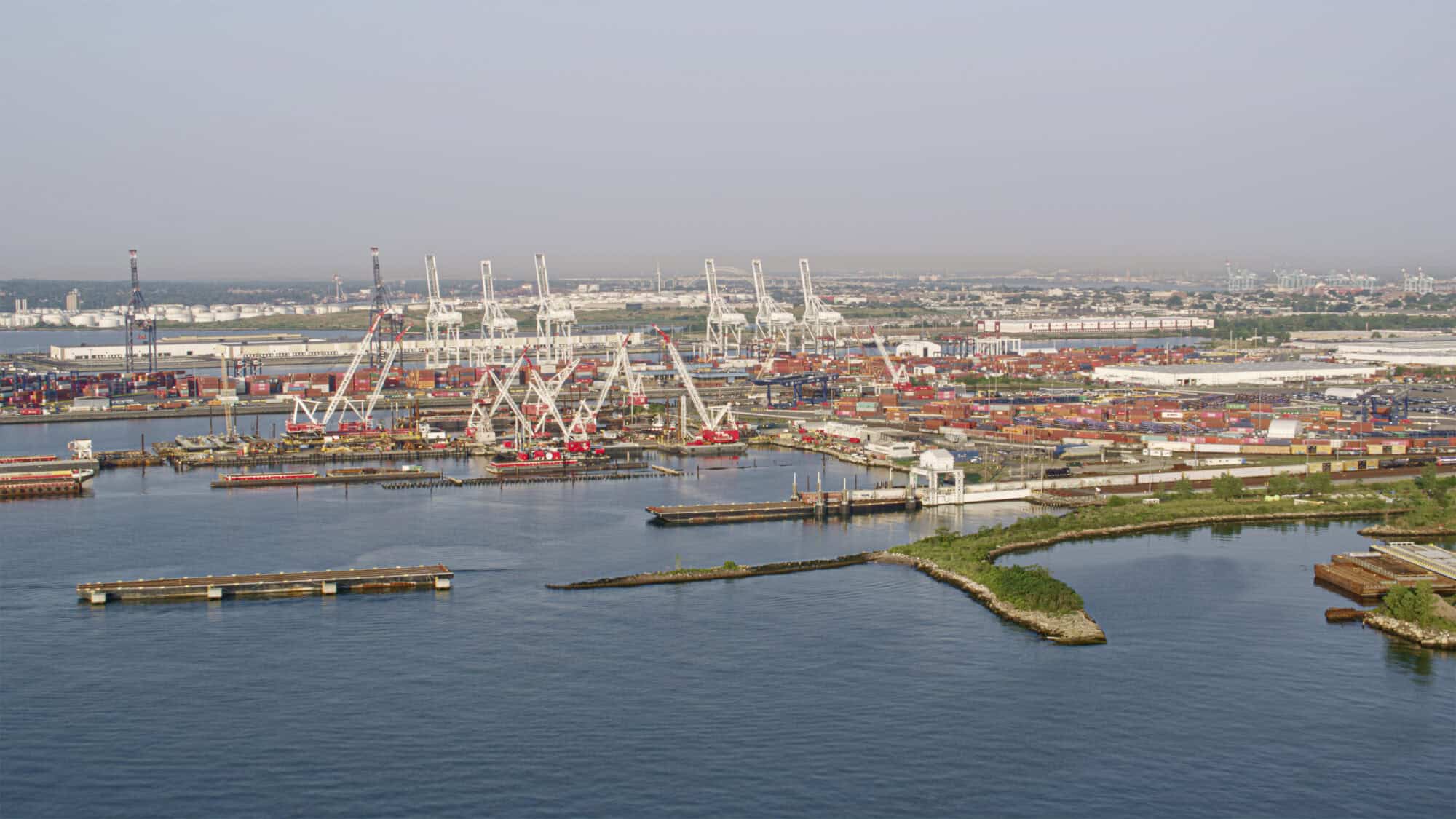
Negotiations between the U.S. Maritime Alliance and the International Longshoremen’s Association have stalled again, “raising the possibility of renewed strikes at U.S. East and Gulf Coast ports in January” (gCaptain).
What’s going on: Talks between the dockworkers and their employers broke down this week over proposed language regarding the use of automation, according to the ILA.
- “This impasse follows a tentative agreement reached in early October, which ended a three-day strike across Atlantic and Gulf Coast ports” and extended the workers’ labor contract until Jan. 15, 2025.
- If the parties are unable to reach a long-term agreement by that date, the union could strike again.
Why it’s problematic: Even a brief work stoppage could have major economic consequences, according to widely cited NAM estimates.
- A strike at East and Gulf Coast ports would jeopardize $2.1 billion in trade every day and could reduce gross domestic product by up to $5 billion a day.
What must be done: “These ports are critical components of the manufacturing supply chain and move products on which Americans depend,” said NAM Director of Transportation, Infrastructure and Labor Policy Max Hyman. “Both sides should return to negotiations as soon as possible and reach a lasting resolution that prevents needless economic destruction.”
NLRB Overturns 40-Year Precedent

When employers tell workers that unionizing would harm employee–manager relationships, they might be violating federal law, the National Labor Relations Board ruled last week (Law360, subscription).
What’s going on: “Telling workers that a union would come between them and their bosses may violate the National Labor Relations Act because it’s an effective threat to end workers’ direct relationships with management, a majority comprising the board’s three Democrats said [last] Friday in a case involving Starbucks.”
- The groundbreaking decision overturns nearly four decades of precedent. In its 1985 Tri-Cast ruling, the NLRB allowed employers to tell employees that unionization would strain worker–manager relationships “so long as they didn’t explicitly or implicitly threaten employees” when doing so (JD Supra).
- The NLRB said such cases will now be decided on a case-by-case basis.
Looking ahead: The ruling will only apply to future cases, however, “allowing past communications under the Tri-Cast standard to stand without retroactive penalties” (JD Supra).
Producer Price Index Rises 0.2% in October
The Producer Price Index for final demand (also known as wholesale prices) increased 0.2% in October, after rising 0.1% in September. Over the past year, the final demand index rose 2.4% on an unadjusted basis, an increase from the 1.9% over-the-year increase in September. Prices for final demand excluding foods, energy and trade services inched up 0.3%, after rising 0.1% in September.
In October, prices for final demand services increased 0.3%, while prices for final demand goods rose just 0.1%. Although both food (-0.2%) and energy (-0.3%) prices declined, a 0.3% increase in prices of other goods more than offset those decreases. The largest underlying increase was a 0.5% rise in transportation and warehousing services prices, while prices for both trade services and other services increased slightly.
Prices within intermediate demand rose 0.5% in October, following two consecutive monthly declines. Processed goods for intermediate demand increased 0.5%, with prices for processed energy goods leading the increase. On the other hand, over the 12 months ending in October, prices for processed goods for intermediate demand fell 1.2%.
Meanwhile, prices for unprocessed goods for intermediate demand moved up 4.1% in October, after declining 1.8% in September. The increase was driven by a 9.9% rise in unprocessed energy materials. Meanwhile, unprocessed foodstuffs and feedstuffs prices edged up just 0.4%, and nonfood materials less energy prices increased 2.1%. Over the 12 months ending in October, prices for unprocessed goods for intermediate demand fell 2.9%.
